Fuel is supplied to the consumer by arranging the gas distribution system - a complex of interconnected facilities and communications. A part of the system are overground and underground gas pipelines, through which fuel is supplied to points of use - to residential buildings and enterprises.
The choice of the place for laying pipes depends on a number of criteria that are analyzed at the design stage. Gas can be supplied to private houses in different ways: by laying pipes in the ground or above the ground. Let's consider both methods and features of their choice.
The content of the article:
- General rules for the construction of the pipeline
- What determines the choice of communications
-
Features of the device of gas lines
- Option # 1 - underground gas pipeline
- Option # 2 - aboveground gas pipeline
- Conclusions and useful video on the topic
General rules for the construction of the pipeline
Gas pipelines are pipe lines, supporting and protective elements, additional equipment. They are used to transport "blue fuel" from the source or GDS to the place of consumption.
At the place of installation, gas communications are divided into two large categories:
- overground - going above the surface of the earth at a certain distance, installed on special supports, placed in casings and cases;
- underground - placed in the ground, in specially dug trenches.
In modern construction, both methods of pipe laying are used.
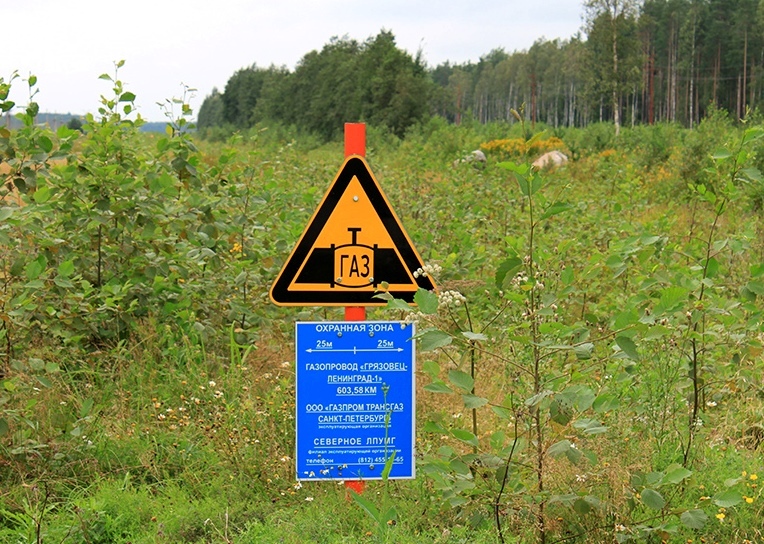
The installation sites of the gas pipeline are classified as especially dangerous zones, therefore, special signs or limiters are installed along the entire length of the pipeline.
The designation plates are painted in different colors. They can be white with blue or red edging, just blue, but the "trademark" color of any gas equipment is yellow.
What determines the choice of communications
A special commission is responsible for the project of the new gas pipeline, which determines the route of the pipeline, the method of its construction, and the points of construction of the gas distribution station.
When choosing a laying method, the following criteria are taken into account:
- the population of the territory where the gas pipeline is planned to be extended;
- the presence on the territory of already stretched underground communications;
- type of soil, type and condition of coatings;
- consumer characteristics - industrial or household;
- the possibilities of various kinds of resources - natural, technical, material, personnel.
An underground installation is considered preferable, which reduces the risk of accidental damage to the pipes and provides a stable temperature regime. This type is practiced more often if you need to supply gas to residential areas or detached buildings.

At industrial enterprises, the highways are carried out overhead - on specially installed supports, along the walls. Open laying is also observed inside buildings.
On rare occasions gas pipes allowed to disguise under a concrete floor - in laboratories, public catering or consumer services. For safety reasons, the gas pipeline is placed in anti-corrosion insulation, poured with cement mortar, in the places where it comes out, placed in reliable cases that ensure stability.
Features of the device of gas lines
When the purpose of the gas pipeline is clear, it is easier to choose the method of its construction or installation material. For example, if you need to connect a detached cottage to the highway, the relief is preliminarily analyzed territories, take soil samples, calculate the distance and the shortest path, look for ways to save resources.
Let us consider in more detail the technical and legal aspects of the arrangement of these types of gas pipelines - underground and aboveground.
Option # 1 - underground gas pipeline
When laying underground utilities, it is important to calculate in advance all the nuances: the length of the main line, the depth of the trench, the type of pipe material.
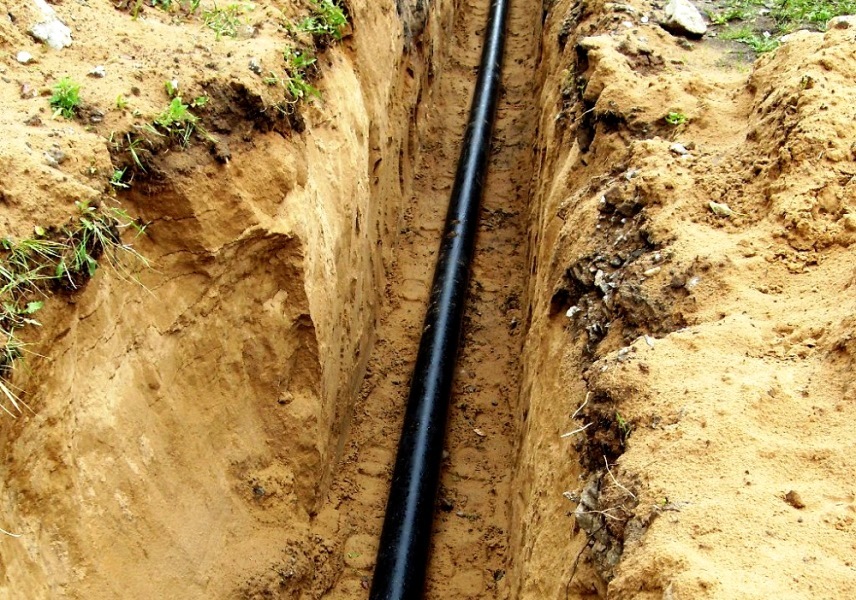
According to the installation rules, the depth of the underground gas pipeline is 0.8 m - not the bottom of the trench is taken into account, but the distance to the top point of the pipe or case
If the territory is deserted, without roads and buildings, a depth reduced to 0.6 m is allowed
On the contrary, the trenches will have to be deepened if the following factors are identified on the site:
- difficult soil and climatic conditions;
- increased dynamic loads;
- The groundwater.
Dynamic loads are typical for cities and industrial zones - these are sharp temperature fluctuations, the presence of highways, tram and railways.
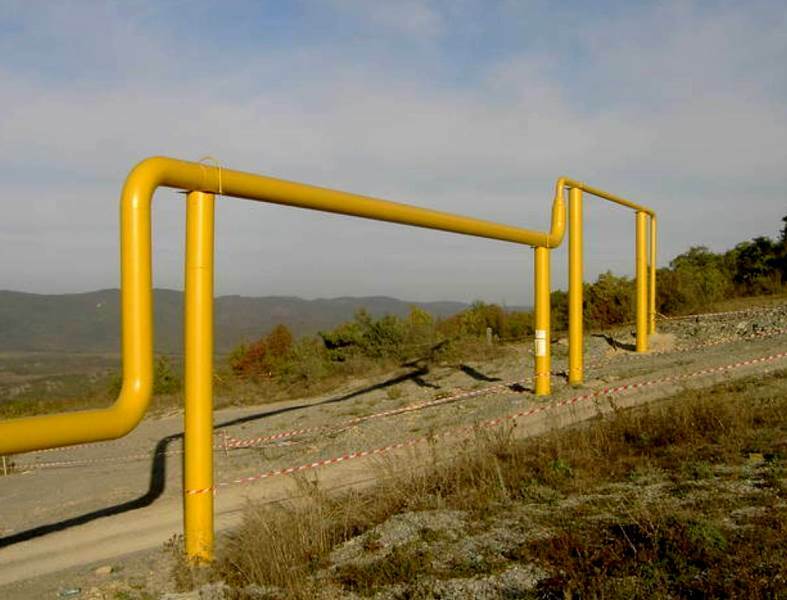
If a road runs through the territory of the summer cottage, the trench for the gas pipeline passing under it is made deeper. In some cases, another type of highway is used - an overhead
If underground gas pipelines intersect with other utilities, certain distances should be observed between them:
- 0.1 m or more - to the rain or drainage sewer;
- 0.2 m or more vertically - to drains, sewer or heat pipes;
- 0.5 m or more - up to telephone, network or electric cable.
The last distance can be shortened if both mains - gas and electric - are enclosed in protective cases.
Reliable protective cases are also used when underground gas routes cross railways or motorways. In this case, the ends of the cases are sealed - packed with a pre-resinous linen strand, and then sealed with bitumen.
Not far from the intersection, at a distance of no more than 1 km, shallow wells are dug and cut-off taps are installed in them. Ring gas pipelines require two disconnecting devices, and dead-end ones - one located on the fuel supply side is enough.

It is possible to lay underground (underwater) pipes in more difficult conditions, when crossing water barriers - canals, rivers, streams. They choose straight sections with a stable, stable channel, calm current, strong, gentle banks, not washed out by water. Reinforced insulation is used for pipes
To save resources and increase the speed of work, it is allowed to lay 2 or more gas pipelines in one trench. They are positioned on the same level or in steps so that quick access and repair is possible. The distance between pipes up to 30 cm in diameter is at least 0.4 m.
In some cases, the slope must be observed, for example, if dry gas is introduced into the building. When installing pipes in freezing soil, condensate traps are installed, and then the slope should lead in their direction.
To prevent sagging of the pipeline, provoking pipe bends and deformation of the joints, they prevent soil subsidence in the trench. To do this, a dense backfill of hard rocks is placed on the bottom, and then a layer of sand.
Installation procedure:
Image gallery
Photo from
Before starting work, markup work is performed, straight sections are verified, as well as horizontal and vertical angles
A trench for pipes is dug out with a single-bucket excavator, the rework is performed manually. At the same time, pipes are transported to the site
The gas pipeline is being installed: pipes are laid in series, they are connected by a welded method. At the end, tests are required.
For backfilling large trenches, special equipment is used, for narrow ditches - manual labor. During backfilling, a signal tape is laid, signs are installed
Layout and geodetic stakeout
Earthworks and material delivery
Installation of pipes in a trench
Backfilling the trench with soil
Digging trenches is not the only way to install an underground gas pipeline. There is also a trenchless laying method - horizontal drilling.
It reduces installation costs by 25-30% and has the following advantages:
- significantly reduces the time frame;
- preserves the established communications and road surfaces;
- protects the environment, including planting.
Briefly about the drilling process: they create a pilot well, expand it to meet the specified parameters, concreting the walls, pulling polymer pipes for the gas pipeline.
But in any case, underground pipelines are more expensive than aboveground ones, and require increased resource costs in case of repair. It is more difficult to find an emergency section in buried highways, therefore, increased requirements are imposed on the installation and protection of pipes.
The rules regarding the operation of gas pipelines can be found in "Rules of technical operation and labor safety requirements in the gas industry of the Russian Federation".
Option # 2 - aboveground gas pipeline
Aboveground gas pipelines are installed where there are no conditions for underground laying or it is recognized as inexpedient. The design and construction of industrial networks are based on the requirements SNiP 2.09.03-85 and SNiP II-89-80.
For the installation of pipes, supports, columns, overpasses and stacks made of non-combustible materials are used. Installation can be done on the walls of buildings, but not all. For example, for industrial premises of categories C, D, D, gas pipelines of no more than 0.6 MPa can be installed, and for children's institutions, schools and hospitals, pipelines of any pressure cannot be used.
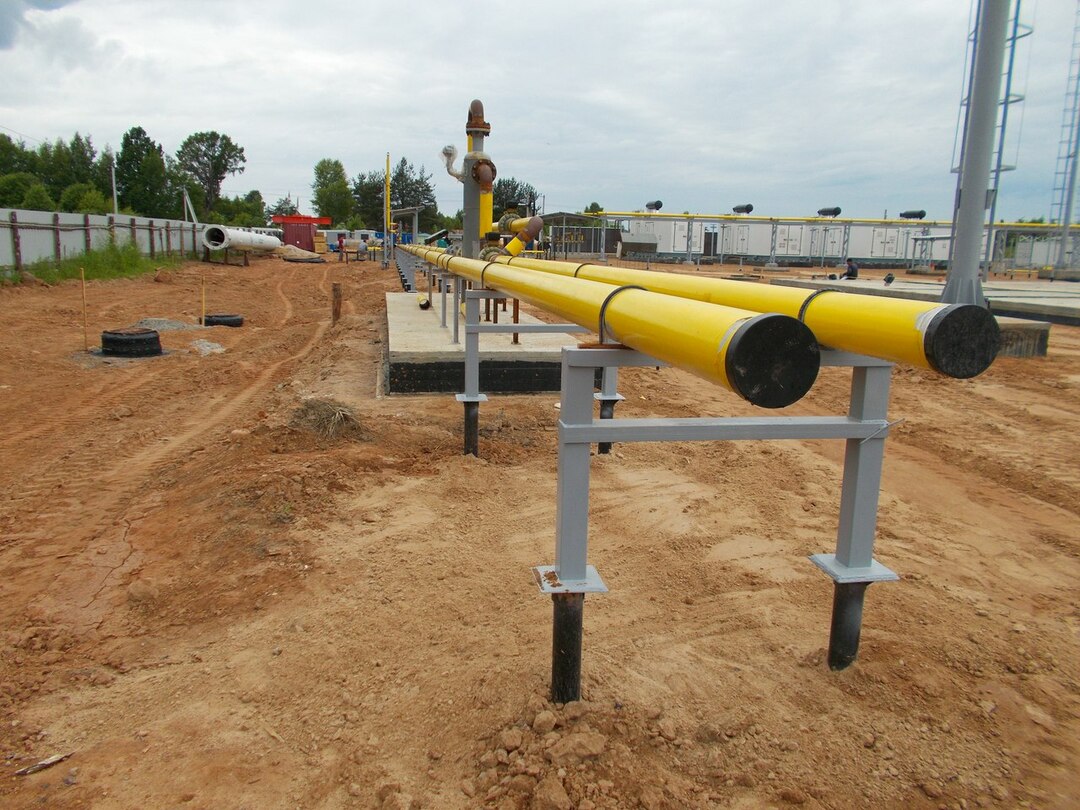
The metal supports on which the pipes are located must be protected as much as possible from corrosion, mechanical damage and weathering - moisture and temperature extremes
On the walls of residential buildings and public buildings only overhead low pressure gas pipelines - no more than 0.3 MPa. Also, it is impossible to lay gas pipelines if the walls of buildings of categories A, B are sheathed with metal panels or polymer insulation.
High-pressure gas lines are laid along the walls of industrial structures of categories C, D, D fire hazard. Pipes are installed above window and doorways, if the building is multi-storey - above the windows of the upper floor.
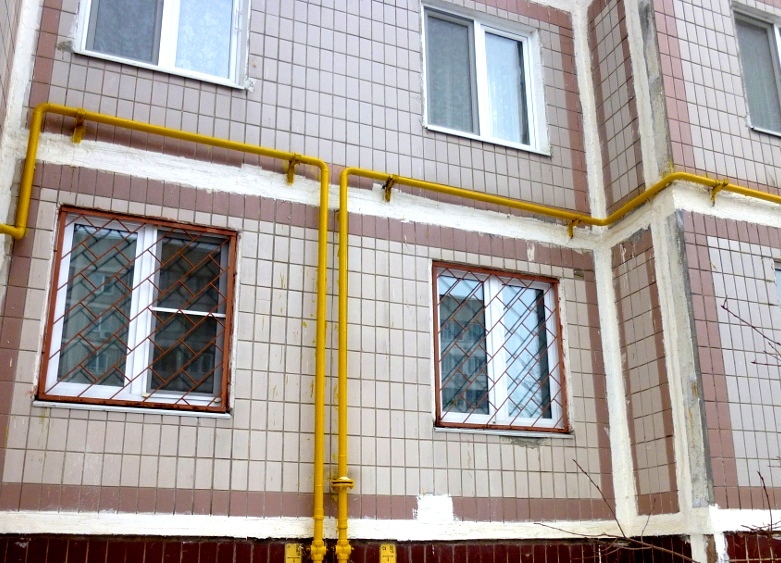
Detachable connections cannot be placed under balconies and windows of residential and public buildings - if you need to connect two pipes, welding is used
Requirements for the height of laying aboveground gas pipelines are set out in SNiP II-89-80. The distance from the ground surface to the lower surface of the pipe or protective case is 0.35 m if the structure is installed on low supports. For groups of pipes with a width of more than 1.5 m, the height increases to 0.5 m.
If the pipes are placed on high supports, the norms are as follows:
- in pedestrian areas - 2.2 m;
- at the intersection with highways - 5 m;
- at the intersection with tram tracks - 7.1 m;
- at intersections with trolleybus wires - 7.3 m.
Height when crossing internal railways is adjustable GOST 9238.
For the production of pipes for above-ground use, special grades of steel are used, the wall thickness is at least 2 mm. Polyethylene pipe material is not used for aboveground gas pipelines.
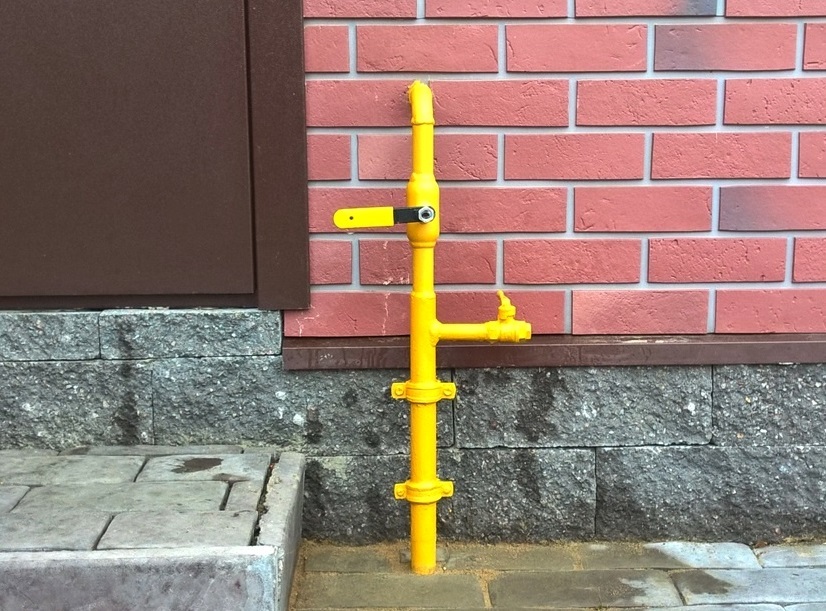
When installing combined utilities, hard cases are installed at the exit points of underground highways - except for areas where the likelihood of damage is excluded
For pipelines supplying non-dried gas, a slope towards the condensate traps is provided for at least 3%.
The distance to overhead power lines, as well as joint laying with electric cables, is regulated by the PUE.
The choice of distances between fixed supports is subject to the requirements SNiP 2.04.12-86. If the diameter of the pipes is up to 30 cm, then the maximum distance is 100 m. With an increase in the diameter, the distance also increases - it is calculated by the formula.
Conclusions and useful video on the topic
Modern method - trenchless laying and repair:
How to quickly dig a trench:
More about the trench pipe laying method:
To establish an uninterrupted gas supply to the consumer, it is important to choose the correct method for installing the gas pipeline and carry out the work in accordance with regulatory requirements. For a private household, an underground pipe-laying method is preferable, in which maximum protection is guaranteed against accidental damage and foreign interference.
If you have your own opinion on this issue, or you can add valuable information to our material, please leave your comments in the block below. There you can also ask a question to our experts or participate in the discussion of the material.


